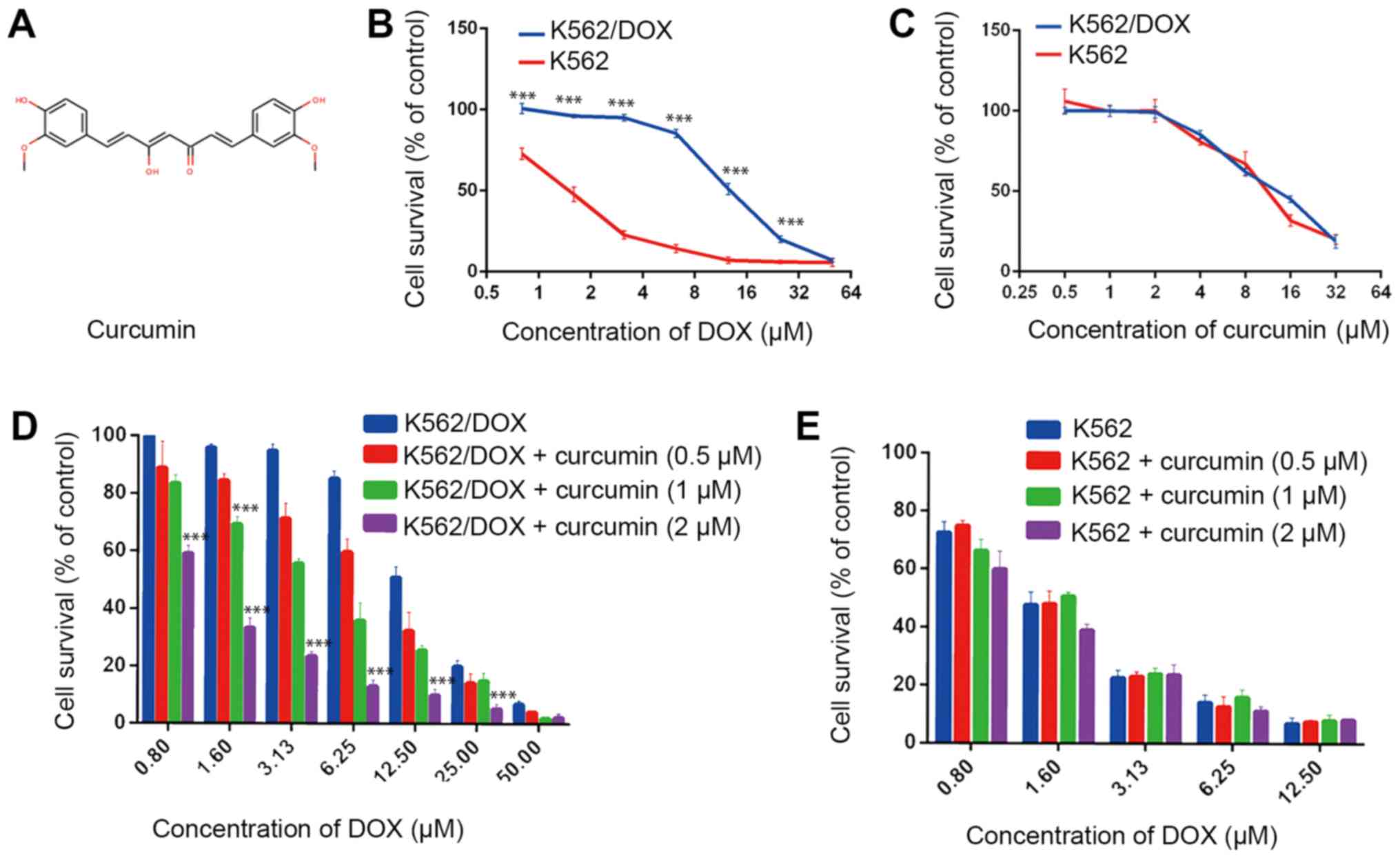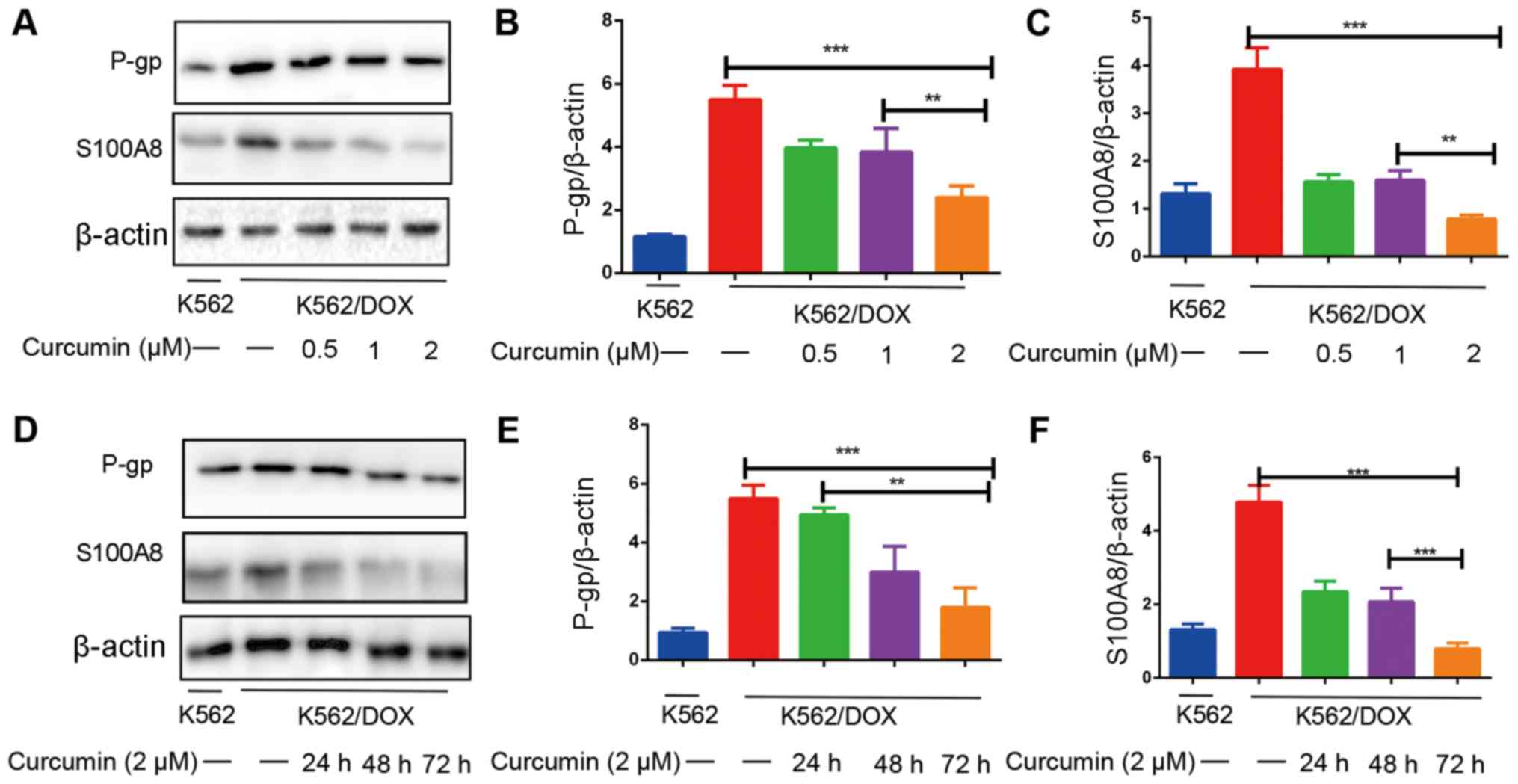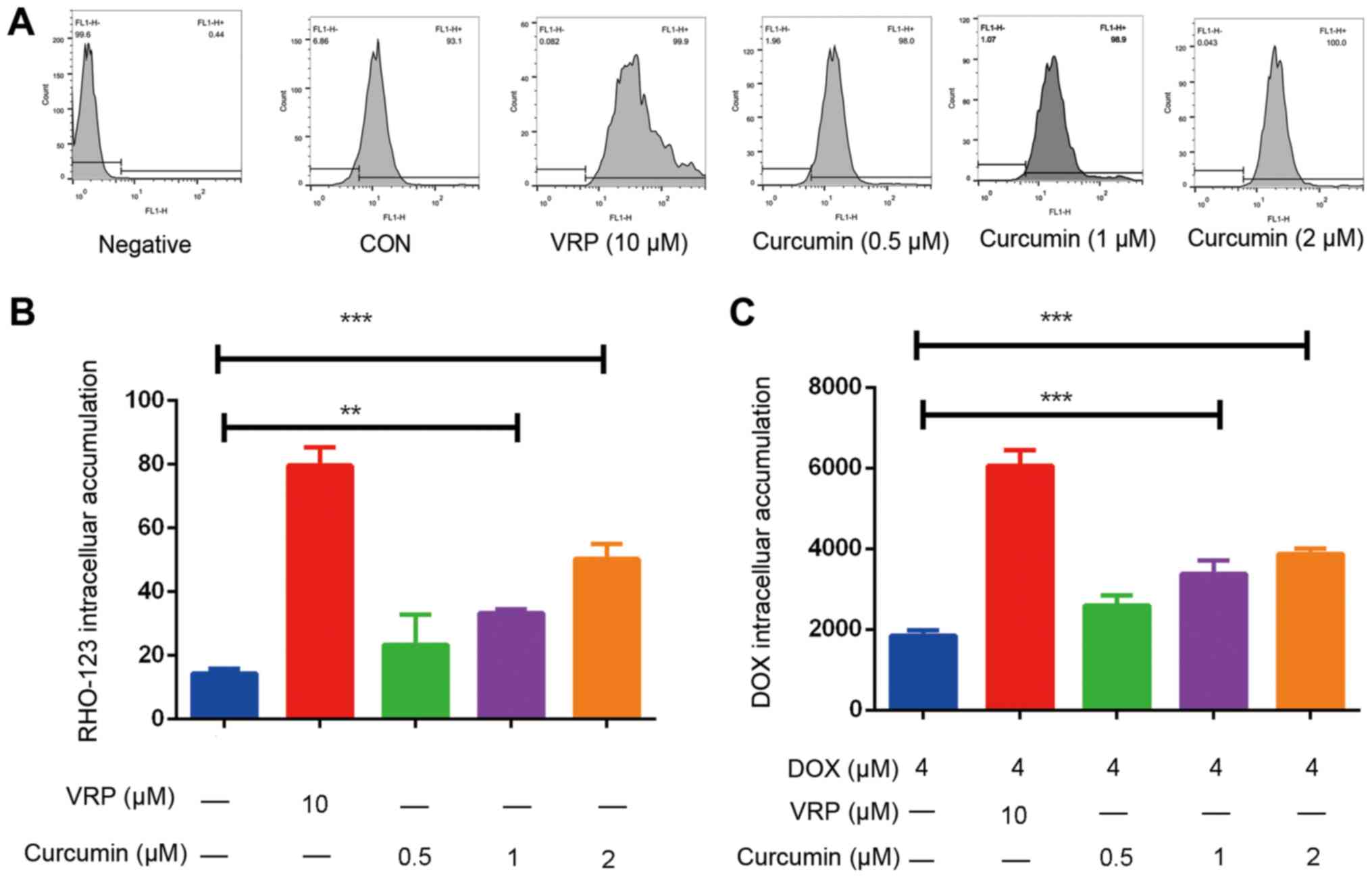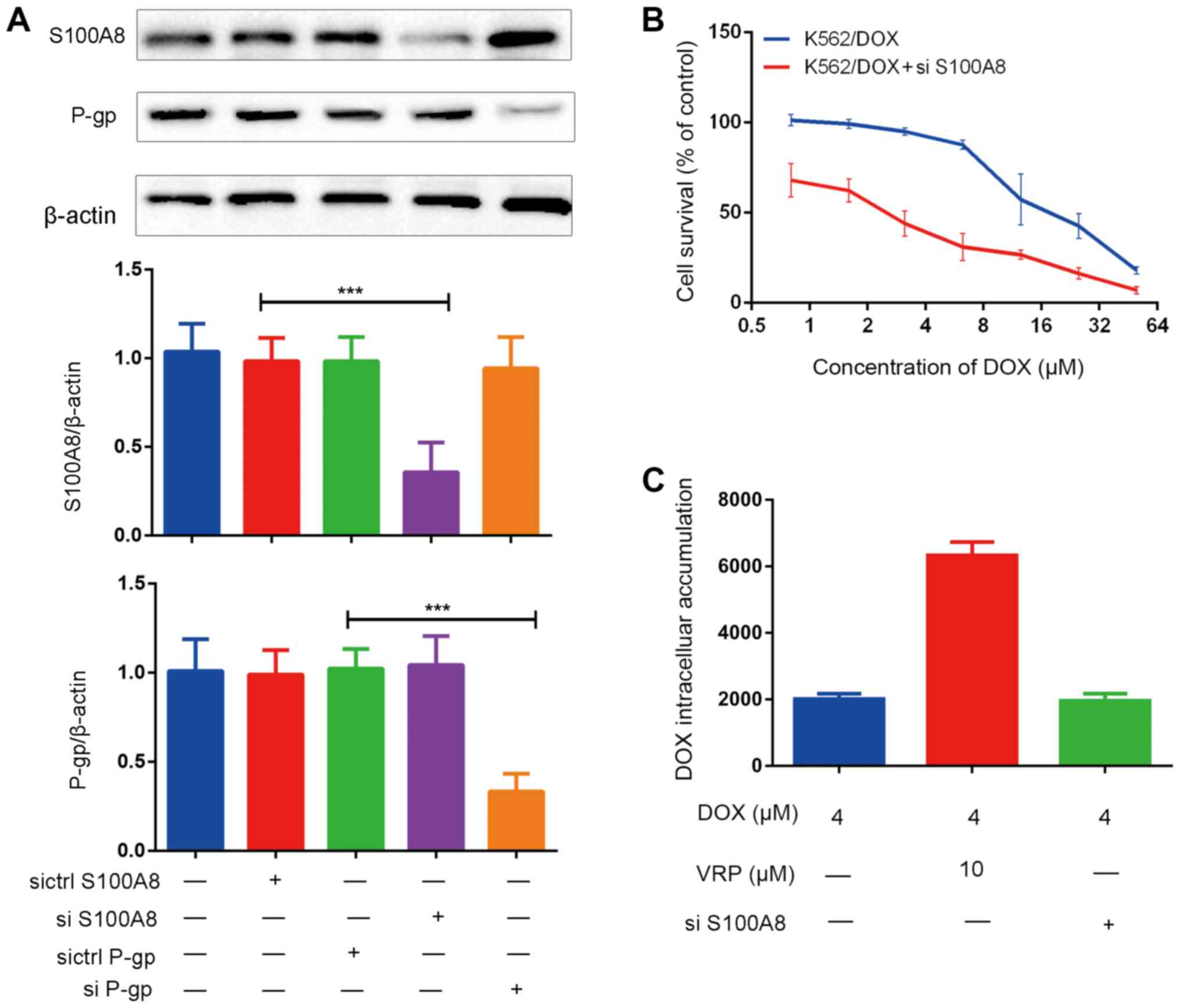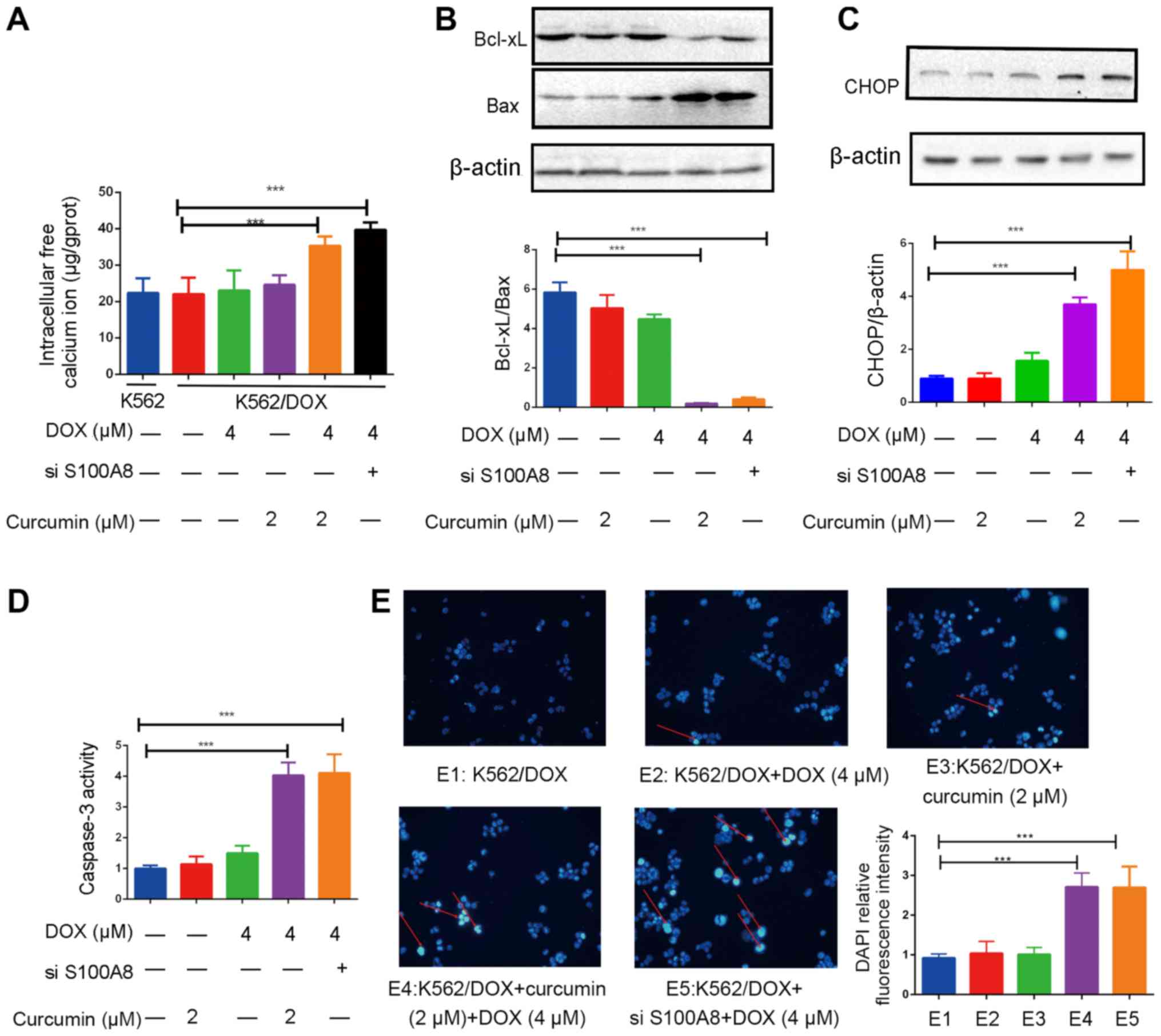|
1
|
Swerdlow S, Campo E, Harris N, Jaffe E,
Pileri S, Stein H, Thiele J and Vardiman J: WHO Classification of
Tumours of Haematopoietic and Lymphoid TissuesIARC; Lyon: 2008
|
|
2
|
Agrawal M, Hanfstein B, Erben P, Wolf D,
Ernst T, Fabarius A, Saussele S, Purkayastha D, Woodman RC, Hofmann
WK, et al: MDR1 expression predicts outcome of Ph+ chronic phase
CML patients on second-line nilotinib therapy after imatinib
failure. Leukemia. 28:1478–1485. 2014. View Article : Google Scholar : PubMed/NCBI
|
|
3
|
Zhang Q, Feng Y and Kennedy D:
Multidrug-resistant cancer cells and cancer stem cells hijack
cellular systems to circumvent systemic therapies, can natural
products reverse this? Cell Mol Life Sci. 74:777–801. 2017.
View Article : Google Scholar : PubMed/NCBI
|
|
4
|
Xia CQ and Smith PG: Drug efflux
transporters and multidrug resistance in acute leukemia:
Therapeutic impact and novel approaches to mediation. Mol
Pharmacol. 82:1008–1021. 2012. View Article : Google Scholar : PubMed/NCBI
|
|
5
|
Briot T, Roger E, Thépot S and Lagarce F:
Advances in treatment formulations for acute myeloid leukemia. Drug
Discov. Today. 23:1936–1949. 2018.
|
|
6
|
Salerno L, Romeo G, Modica MN, Amata E,
Sorrenti V, Barbagallo I and Pittalà V: Heme oxygenase-1: A new
druggable target in the management of chronic and acute myeloid
leukemia. Eur J Med Chem. 142:163–178. 2017. View Article : Google Scholar : PubMed/NCBI
|
|
7
|
Tsuruo T, Iida H, Tsukagoshi S and Sakurai
Y: Overcoming of vincristine resistance in P388 leukemia in vivo
and in vitrothrough enhanced cytotoxicity of vincristine and
vinblastine by verapamil. Cancer Res. 41:1967–1972. 1981.PubMed/NCBI
|
|
8
|
Batra P and Sharma AK: Anti-cancer
potential of flavonoids: Recent trends and future perspectives. 3
Biotech. 3:439–459. 2013. View Article : Google Scholar : PubMed/NCBI
|
|
9
|
Jacquemin G, Granci V, Gallouet AS,
Lalaoui N, Morlé A, Iessi E, Morizot A, Garrido C, Guillaudeux T
and Micheau O: Quercetin-mediated Mcl-1 and survivin downregulation
restores TRAIL-induced apoptosis in non-Hodgkin's lymphoma B cells.
Haematologica. 97:38–46. 2012. View Article : Google Scholar : PubMed/NCBI
|
|
10
|
Goel A, Kunnumakkara AB and Aggarwal BB:
Curcumin as ‘Curecumin’: From kitchen to clinic. Biochem Pharmacol.
75:787–809. 2008. View Article : Google Scholar : PubMed/NCBI
|
|
11
|
Ravindran J, Prasad S and Aggarwal BB:
Curcumin and cancer cells: How many ways can curry Kill tumor cells
selectively? AAPS J. 11:495–510. 2009. View Article : Google Scholar : PubMed/NCBI
|
|
12
|
Banerjee S, Ji C, Mayfield JE, Goel A,
Xiao J, Dixon JE and Guo X: Ancient drug curcumin impedes 26S
proteasome activity by direct inhibition of dual-specificity
tyrosine-regulated kinase 2. Proc Natl Acad Sci USA. 115:8155–8160.
2018. View Article : Google Scholar : PubMed/NCBI
|
|
13
|
Romiti N, Tongiani R, Cervelli F and
Chieli E: Effects of curcumin on P-glycoprotein in primary cultures
of rat hepatocytes. Life Sci. 62:2349–2358. 1998. View Article : Google Scholar : PubMed/NCBI
|
|
14
|
Gu Y, Li J, Li Y, Song L, Li D, Peng L,
Wan Y and Hua S: Nanomicelles loaded with doxorubicin and curcumin
for alleviating multidrug resistance in lung cancer. Int J
Nanomedicine. 11:5757–5770. 2016. View Article : Google Scholar : PubMed/NCBI
|
|
15
|
Mapoung S, Pitchakarn P, Yodkeeree S,
Ovatlarnporn C, Sakorn N and Limtrakul P: Chemosensitizing effects
of synthetic curcumin analogs on human multi-drug resistance
leukemic cells. Chem Biol Interact. 244:140–148. 2016. View Article : Google Scholar : PubMed/NCBI
|
|
16
|
Maia RC, Vasconcelos FC, Souza PS and
Rumjanek VM: Towards Comprehension of the ABCB1/P-glycoprotein role
in chronic myeloid leukemia. Molecules. 23(pii): E1192018.
View Article : Google Scholar : PubMed/NCBI
|
|
17
|
Lalioti VS, Ilari A, O'Connell DJ, Poser
E, Sandoval IV and Colotti G: Sorcin links calcium signaling to
vesicle trafficking, regulates Polo-like kinase 1 and is necessary
for mitosis. PLoS One. 9:e854382014. View Article : Google Scholar : PubMed/NCBI
|
|
18
|
Bresnick AR, Weber DJ and Zimmer DB: S100
proteins in cancer. Nat Rev Cancer. 15:96–109. 2015. View Article : Google Scholar : PubMed/NCBI
|
|
19
|
Salama I, Malone PS, Mihaimeed F and Jones
JL: A review of the S100 proteins in cancer. Eur J Surg Oncol.
34:357–364. 2008. View Article : Google Scholar : PubMed/NCBI
|
|
20
|
Nicolas E, Ramus C, Berthier S, Arlotto M,
Bouamrani A, Lefebvre C, Morel F, Garin J, Ifrah N, Berger F, et
al: Expression of S100A8 in leukemic cells predicts poor survival
in de novo AML patients. Leukemia. 25:57–65. 2011. View Article : Google Scholar : PubMed/NCBI
|
|
21
|
Spijkers-Hagelstein JA, Schneider P,
Hulleman E, de Boer J, Williams O, Pieters R and Stam RW: Elevated
S100A8/S100A9 expression causes glucocorticoid resistance in
MLL-rearranged infant acute lymphoblastic leukemia. Leukemia.
26:1255–1265. 2012. View Article : Google Scholar : PubMed/NCBI
|
|
22
|
Yang XY, Zhang MY, Zhou Q, Wu SY, Zhao Y,
Gu WY, Pan J, Cen JN, Chen ZX, Guo WG, et al: High expression of
S100A8 gene is associated with drug resistance to etoposide and
poor prognosis in acute myeloid leukemia through influencing the
apoptosis pathway. Onco Targets Ther. 9:4887–4899. 2016. View Article : Google Scholar : PubMed/NCBI
|
|
23
|
Yang M, Zeng P, Kang R, Yu Y, Yang L, Tang
D and Cao L: S100A8 contributes to drug resistance by promoting
autophagy in leukemia cells. PLoS One. 9:e972422014. View Article : Google Scholar : PubMed/NCBI
|
|
24
|
Lampidis TJ, Shi YF, Calderon CL, Kolonias
D, Tapiero H and Savaraj N: Accumulation of simple organic cations
correlates with differential cytotoxicity in multidrug-resistant
and -sensitive human and rodent cells. Leukemia. 11:1156–1159.
1997. View Article : Google Scholar : PubMed/NCBI
|
|
25
|
Liu Y, Zhang SP and Cai YQ: Cytoprotective
effects of selenium on cadmium-induced LLC-PK1 cells apoptosis by
activating JNK pathway. Toxicol In Vitro. 21:677–684. 2007.
View Article : Google Scholar : PubMed/NCBI
|
|
26
|
Zhou H, Qian J, Wang J, Yao W, Liu C, Chen
J and Cao X: Enhanced bioactivity of bone morphogenetic protein-2
with low dose of 2-N, 6-O-sulfated chitosan in vitro and in vivo.
Biomaterials. 30:1715–1724. 2009. View Article : Google Scholar : PubMed/NCBI
|
|
27
|
Kapuscinski J: DAPI: A DNA-specific
fluorescent probe. Biotech Histochem. 70:220–233. 1995. View Article : Google Scholar : PubMed/NCBI
|
|
28
|
Yan P, Li T, Bo M, Die L and Xing L:
Inhibition of bone resorption by econazole in rat osteoclast-like
cells through suppressing TRPV5. Arch Pharm Res. 34:1007–1013.
2011. View Article : Google Scholar : PubMed/NCBI
|
|
29
|
Yhee JY, Song S, Lee SJ, Park SG, Kim KS,
Kim MG, Son S, Koo H, Kwon IC, Jeong JH, et al: Cancer-targeted
MDR-1 siRNA delivery using self-cross-linked glycol chitosan
nanoparticles to overcome drug resistance. J Control Release.
198:1–9. 2015. View Article : Google Scholar : PubMed/NCBI
|
|
30
|
Yan LL, Huang YJ, Yi X, Yan XM, Cai Y, He
Q and Han ZJ: Effects of silencing S100A8 and S100A9 with small
interfering RNA on the migration of CNE1 nasopharyngeal carcinoma
cells. Oncol Lett. 9:2534–2540. 2015. View Article : Google Scholar : PubMed/NCBI
|
|
31
|
Morsy MA, El-Sheikh AAK, Ibrahim ARN,
Khedr MA and Al-Taher AY: In silico comparisons between natural
inhibitors of ABCB1/P-glycoprotein to overcome
doxorubicin-resistance in the NCI/ADR-RES cell line. Eur J Pharm
Sci. 112:87–94. 2018. View Article : Google Scholar : PubMed/NCBI
|
|
32
|
Fletcher JI, Williams RT, Henderson MJ,
Norris MD and Haber M: ABC transporters as mediators of drug
resistance and contributors to cancer cell biology. Drug Resist
Updat. 26:1–9. 2016. View Article : Google Scholar : PubMed/NCBI
|
|
33
|
Servili E, Trus M, Maayan D and Atlas D:
β-Subunit of the voltage-gated Ca2+ channel Cav1.2 drives signaling
to the nucleus via H-Ras. Proc Natl Acad Sci USA. 115:E8624–E8633.
2018. View Article : Google Scholar : PubMed/NCBI
|
|
34
|
DeCaen PG, Delling M, Vien TN and Clapham
DE: Direct recording and molecular identification of the calcium
channel of primary cilia. Nature. 504:315–318. 2013. View Article : Google Scholar : PubMed/NCBI
|
|
35
|
Monteith GR, Prevarskaya N and
Roberts-Thomson SJ: The calcium-cancer signalling nexus. Nat Rev
Cancer. 17:367–380. 2017. View Article : Google Scholar : PubMed/NCBI
|
|
36
|
Hajnóczky G, Booth D, Csordás G,
Debattisti V, Golenár T, Naghdi S, Niknejad N, Paillard M, Seifert
EL and Weaver D: Reliance of ER-mitochondrial calcium signaling on
mitochondrial EF-hand Ca 2+ binding proteins: Miros, MICUs, LETM1
and solute carriers. Curr Opin Cell Biol. 29:133–141. 2014.
View Article : Google Scholar : PubMed/NCBI
|
|
37
|
Andjelkovic T, Pesic M, Bankovic J, Tanic
N, Markovic ID and Ruzdijic S: Synergistic effects of the purine
analog sulfinosine and curcumin on the multidrug resistant human
non-small cell lung carcinoma cell line (NCI-H460/R). Cancer Biol
Ther. 7:1024–1032. 2008. View Article : Google Scholar : PubMed/NCBI
|
|
38
|
Chiu LY, Ko JL, Lee YJ, Yang TY, Tee YT
and Sheu GT: L-type calcium channel blockers reverse docetaxel and
vincristine-induced multidrug resistance independent of ABCB1
expression in human lung cancer cell lines. Toxicol Lett.
192:408–418. 2010. View Article : Google Scholar : PubMed/NCBI
|
|
39
|
Prasad N, Sudhakar YA and Kanwar JR:
Curcumin regulates colon cancer by inhibiting P-Glycoprotein in
In-situ Cancerous colon perfusion rat model. J Cancer Sci Ther.
5:313–319. 2013.PubMed/NCBI
|
|
40
|
Shah K, Mirza S, Desai U, Jain N and Rawal
R: Synergism of curcumin and cytarabine in the down regulation of
Multi-Drug resistance genes in acute myeloid leukemia. Anticancer
Agents Med Chem. 16:128–135. 2016. View Article : Google Scholar : PubMed/NCBI
|
|
41
|
Misra R and Sahoo SK: Coformulation of
doxorubicin and curcumin in poly(D,L-lactide-co-glycolide)
nanoparticles suppresses the development of multidrug resistance in
K562 cells. Mol Pharm. 8:852–866. 2011. View Article : Google Scholar : PubMed/NCBI
|
|
42
|
Anuchapreeda S, Thanarattanakorn P,
Sittipreechacharn S, Tima S, Chanarat P and Limtrakul P: Inhibitory
effect of curcumin on MDR1 gene expression in patient leukemic
cells. Arch Pharm Res. 29:866–873. 2006. View Article : Google Scholar : PubMed/NCBI
|
|
43
|
Choi BH, Kim CG, Lim Y, Shin SY and Lee
YH: Curcumin down-regulates the multidrug-resistance mdr1b gene by
inhibiting the PI3K/Akt/NF kappa B pathway. Cancer Lett.
259:111–118. 2008. View Article : Google Scholar : PubMed/NCBI
|
|
44
|
Robey RW, Pluchino KM, Hall MD, Fojo AT,
Bates SE and Gottesman MM: Revisiting the role of ABC transporters
in multidrug-resistant cancer. Nat Rev Cancer. 18:452–464. 2018.
View Article : Google Scholar : PubMed/NCBI
|
|
45
|
Yang SS, Liu AL, Shan LL, Zeng TC, Zhou Q
and Li YB: Pharmacokinetics mechanism of ABC efflux
proteins-mediated seven features of compatibility. Zhongguo Zhong
Yao Za Zhi. 43:676–683. 2018.(In Chinese). PubMed/NCBI
|
|
46
|
Efferth T and Volm M: Multiple resistance
to carcinogens and xenobiotics: P-glycoproteins as universal
detoxifiers. Arch Toxicol. 91:2515–2538. 2017. View Article : Google Scholar : PubMed/NCBI
|
|
47
|
Huang J, Guo L, Tan R, Wei M, Zhang J,
Zhao Y, Gong L, Huang Z and Qiu X: Interactions between emodin and
efflux transporters on rat enterocyte by a validated ussing chamber
technique. Front Pharmacol. 9:6462018. View Article : Google Scholar : PubMed/NCBI
|
|
48
|
Ampasavate C, Sotanaphun U, Phattanawasin
P and Piyapolrungroj N: Effects of curcuma spp. on P-glycoprotein
function. Phytomedicine. 17:506–512. 2010. View Article : Google Scholar : PubMed/NCBI
|
|
49
|
Monteith GR, Prevarskaya N and
Roberts-Thomson SJ: The calcium-cancer signalling nexus. Nat Rev
Cancer. 17:367–380. 2017. View Article : Google Scholar : PubMed/NCBI
|
|
50
|
Kania E, Roest G, Vervliet T, Parys JB and
Bultynck G: IP3Receptor-mediated calcium signaling and its role in
autophagy in cancer. Front Oncol. 7:1402017. View Article : Google Scholar : PubMed/NCBI
|
|
51
|
Dubois C, Vanden Abeele F and Prevarskaya
N: Targeting apoptosis by the remodelling of calcium-transporting
proteins in cancerogenesis. FEBS J. 280:5500–5510. 2013. View Article : Google Scholar : PubMed/NCBI
|
|
52
|
Roderick HL and Bootman MD: Redoxing
calcium from the ER. Cell. 120:4–5. 2005. View Article : Google Scholar : PubMed/NCBI
|
|
53
|
Clapham DE: Calcium signaling. Cell.
131:1047–1058. 2007. View Article : Google Scholar : PubMed/NCBI
|
|
54
|
Luciani DS, Gwiazda KS, Yang TL, Kalynyak
TB, Bychkivska Y, Frey MH, Jeffrey KD, Sampaio AV, Underhill TM and
Johnson JD: Roles of IP3R and RyR Ca2+Channels in endoplasmic
reticulum stress and β-cell death. Diabetes. 58:422–432. 2009.
View Article : Google Scholar : PubMed/NCBI
|
|
55
|
Dubois C, Vanden Abeele F, Sehgal P,
Olesen C, Junker S, Christensen SB, Prevarskaya N and Møller JV:
Differential effects of thapsigargin analogues on apoptosis of
prostate cancer cells: Complex regulation by intracellular calcium.
FEBS J. 280:5430–5440. 2013. View Article : Google Scholar : PubMed/NCBI
|
|
56
|
Ansari N, Hadi-Alijanvand H, Sabbaghian M,
Kiaei M and Khodagholi F: Interaction of 2-APB, dantrolene, and
TDMT with IP3R and RyR modulates ER stress-induced programmed cell
death I and II in neuron-like PC12 cells: An experimental and
computational investigation. J Biomol Struct Dyn. 32:1211–1230.
2014. View Article : Google Scholar : PubMed/NCBI
|
|
57
|
Bouman L, Schlierf A, Lutz AK, Shan J,
Deinlein A, Kast J, Galehdar Z, Palmisano V, Patenge N, Berg D, et
al: Parkin is transcriptionally regulated by ATF4: Evidence for an
interconnection between mitochondrial stress and ER stress. Cell
Death Differ. 18:769–782. 2011. View Article : Google Scholar : PubMed/NCBI
|















